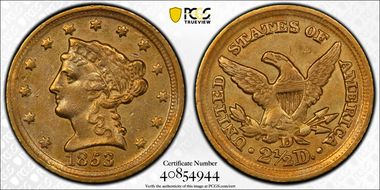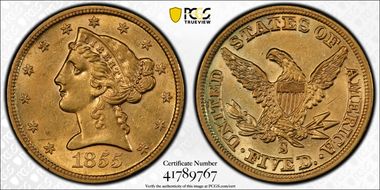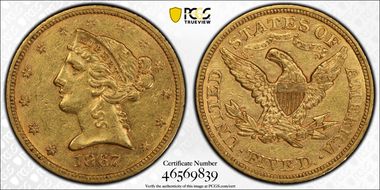hykyrone 的钱币相册
A single variety exists - Winter 17-N Douglas Winter's "Gold Coins of the Dahlonega Mint 1838-1861" also indicates the rarity is 7th of 20. He states, "The 1853-D quarter eagle is scarce in all grades. It is seen most often in VF to XF range..." Garrett and Guth's "Encyclopedia of U.S. Gold Coins 1795-1933" echos the rarity, stating, "As the tiny mintage suggests, the 1853-D quarter eagle must be considered rare in any grade. Perhaps fewer than 100 coins still survive in all grades."
A single variety exists - Winter 17-N Douglas Winter's "Gold Coins of the Dahlonega Mint 1838-1861" also indicates the rarity is 7th of 20. He states, "The 1853-D quarter eagle is scarce in all grades. It is seen most often in VF to XF range..." Garrett and Guth's "Encyclopedia of U.S. Gold Coins 1795-1933" echos the rarity, stating, "As the tiny mintage suggests, the 1853-D quarter eagle must be considered rare in any grade. Perhaps fewer than 100 coins still survive in all grades."
A single variety exists - Winter 17-N Douglas Winter's "Gold Coins of the Dahlonega Mint 1838-1861" also indicates the rarity is 7th of 20. He states, "The 1853-D quarter eagle is scarce in all grades. It is seen most often in VF to XF range..." Garrett and Guth's "Encyclopedia of U.S. Gold Coins 1795-1933" echos the rarity, stating, "As the tiny mintage suggests, the 1853-D quarter eagle must be considered rare in any grade. Perhaps fewer than 100 coins still survive in all grades."
A single variety exists - Winter 17-N Douglas Winter's "Gold Coins of the Dahlonega Mint 1838-1861" also indicates the rarity is 7th of 20. He states, "The 1853-D quarter eagle is scarce in all grades. It is seen most often in VF to XF range..." Garrett and Guth's "Encyclopedia of U.S. Gold Coins 1795-1933" echos the rarity, stating, "As the tiny mintage suggests, the 1853-D quarter eagle must be considered rare in any grade. Perhaps fewer than 100 coins still survive in all grades."
A single variety exists - Winter 17-N Douglas Winter's "Gold Coins of the Dahlonega Mint 1838-1861" also indicates the rarity is 7th of 20. He states, "The 1853-D quarter eagle is scarce in all grades. It is seen most often in VF to XF range..." Garrett and Guth's "Encyclopedia of U.S. Gold Coins 1795-1933" echos the rarity, stating, "As the tiny mintage suggests, the 1853-D quarter eagle must be considered rare in any grade. Perhaps fewer than 100 coins still survive in all grades."
First obtainable San Fransisco half eagle. Diagnostic (die chip?) at star 13 dentils is common to all 1855-S half eagles I've seen. Walter Breen in his monographs and encyclopedia suggests that multiple obverses exist with dates high or very high, however I haven't seen his " date placed very high, with tops of 5's weak, and 1 almost touching bust..." variety. The mint mark is located between the VE in FIVE although there appears to be slight differences in tilt and again from what I've seen this tilt difference is miniscule at most. Garrett and Guth in their "Encyclopedia of U.S. Gold Coins" state, "The moderately high mintage of 61,000 coins fails to truly convey the rarity of the 1855-S half eagle. This issue saw extensive commercial usage and most of the surviving coins are heavily circulated or damaged."
First obtainable San Fransisco half eagle. Diagnostic (die chip?) at star 13 dentils is common to all 1855-S half eagles I've seen. Walter Breen in his monographs and encyclopedia suggests that multiple obverses exist with dates high or very high, however I haven't seen his " date placed very high, with tops of 5's weak, and 1 almost touching bust..." variety. The mint mark is located between the VE in FIVE although there appears to be slight differences in tilt and again from what I've seen this tilt difference is miniscule at most. Garrett and Guth in their "Encyclopedia of U.S. Gold Coins" state, "The moderately high mintage of 61,000 coins fails to truly convey the rarity of the 1855-S half eagle. This issue saw extensive commercial usage and most of the surviving coins are heavily circulated or damaged."
First obtainable San Fransisco half eagle. Diagnostic (die chip?) at star 13 dentils is common to all 1855-S half eagles I've seen. Walter Breen in his monographs and encyclopedia suggests that multiple obverses exist with dates high or very high, however I haven't seen his " date placed very high, with tops of 5's weak, and 1 almost touching bust..." variety. The mint mark is located between the VE in FIVE although there appears to be slight differences in tilt and again from what I've seen this tilt difference is miniscule at most. Garrett and Guth in their "Encyclopedia of U.S. Gold Coins" state, "The moderately high mintage of 61,000 coins fails to truly convey the rarity of the 1855-S half eagle. This issue saw extensive commercial usage and most of the surviving coins are heavily circulated or damaged."
First obtainable San Fransisco half eagle. Diagnostic (die chip?) at star 13 dentils is common to all 1855-S half eagles I've seen. Walter Breen in his monographs and encyclopedia suggests that multiple obverses exist with dates high or very high, however I haven't seen his " date placed very high, with tops of 5's weak, and 1 almost touching bust..." variety. The mint mark is located between the VE in FIVE although there appears to be slight differences in tilt and again from what I've seen this tilt difference is miniscule at most. Garrett and Guth in their "Encyclopedia of U.S. Gold Coins" state, "The moderately high mintage of 61,000 coins fails to truly convey the rarity of the 1855-S half eagle. This issue saw extensive commercial usage and most of the surviving coins are heavily circulated or damaged."
First obtainable San Fransisco half eagle. Diagnostic (die chip?) at star 13 dentils is common to all 1855-S half eagles I've seen. Walter Breen in his monographs and encyclopedia suggests that multiple obverses exist with dates high or very high, however I haven't seen his " date placed very high, with tops of 5's weak, and 1 almost touching bust..." variety. The mint mark is located between the VE in FIVE although there appears to be slight differences in tilt and again from what I've seen this tilt difference is miniscule at most. Garrett and Guth in their "Encyclopedia of U.S. Gold Coins" state, "The moderately high mintage of 61,000 coins fails to truly convey the rarity of the 1855-S half eagle. This issue saw extensive commercial usage and most of the surviving coins are heavily circulated or damaged."
Garrett and Guth's "Encyclopedia of U.S. Gold Coins" states, "The 1867 half eagle has nearly the same mintage as the 1866 issue and is of similar rarity. This date is very rare in all grades, with the typical specimen being heavily circulated." Breen considers the 1867 half eagle to be "Very rare" in his "Complete Encyclopedia of U.S. and Colonial Coins" David Aker's "Analysis of Auction Records - Volume IV - Half Eagles" opines, "With respect to both mintage and frequency of appearance, the 1867 is of almost identical rarity to the 1866. The known business strikes of this date are almost always well worn and VF or EF specimens are typical." His average grade is listed as VF-33.
Garrett and Guth's "Encyclopedia of U.S. Gold Coins" states, "The 1867 half eagle has nearly the same mintage as the 1866 issue and is of similar rarity. This date is very rare in all grades, with the typical specimen being heavily circulated." Breen considers the 1867 half eagle to be "Very rare" in his "Complete Encyclopedia of U.S. and Colonial Coins" David Aker's "Analysis of Auction Records - Volume IV - Half Eagles" opines, "With respect to both mintage and frequency of appearance, the 1867 is of almost identical rarity to the 1866. The known business strikes of this date are almost always well worn and VF or EF specimens are typical." His average grade is listed as VF-33.
Garrett and Guth's "Encyclopedia of U.S. Gold Coins" states, "The 1867 half eagle has nearly the same mintage as the 1866 issue and is of similar rarity. This date is very rare in all grades, with the typical specimen being heavily circulated." Breen considers the 1867 half eagle to be "Very rare" in his "Complete Encyclopedia of U.S. and Colonial Coins" David Aker's "Analysis of Auction Records - Volume IV - Half Eagles" opines, "With respect to both mintage and frequency of appearance, the 1867 is of almost identical rarity to the 1866. The known business strikes of this date are almost always well worn and VF or EF specimens are typical." His average grade is listed as VF-33.
Rarity 17th of 21 per Douglas Winter's "Gold Coins of the New Orleans Mint 1839-1909". Variety 2 (2-A), Obverse - the 1 in the date is equidistant between truncation and dentils, 3 closer to dentils than truncation. Reverse - Mintmark positioned over left side of N in TEN.
Rarity 17th of 21 per Douglas Winter's "Gold Coins of the New Orleans Mint 1839-1909". Variety 2 (2-A), Obverse - the 1 in the date is equidistant between truncation and dentils, 3 closer to dentils than truncation. Reverse - Mintmark positioned over left side of N in TEN.
Rarity 17th of 21 per Douglas Winter's "Gold Coins of the New Orleans Mint 1839-1909". Variety 2 (2-A), Obverse - the 1 in the date is equidistant between truncation and dentils, 3 closer to dentils than truncation. Reverse - Mintmark positioned over left side of N in TEN.
Rarity 17th of 21 per Douglas Winter's "Gold Coins of the New Orleans Mint 1839-1909". Variety 2 (2-A), Obverse - the 1 in the date is equidistant between truncation and dentils, 3 closer to dentils than truncation. Reverse - Mintmark positioned over left side of N in TEN.
Only 2 graded higher by PCGS, NGC and ANACS; (1) PCGS MS64+, (1) NGC MS65
Only 2 graded higher by PCGS, NGC and ANACS; (1) PCGS MS64+, (1) NGC MS65






































